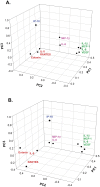Salivary inflammatory mediator profiling and correlation to clinical disease markers in asthma
- PMID: 24409298
- PMCID: PMC3883659
- DOI: 10.1371/journal.pone.0084449
Salivary inflammatory mediator profiling and correlation to clinical disease markers in asthma
Abstract
Rationale: There is a need for a readily available, non-invasive source of biomarkers that predict poor asthma control.
Objectives: We sought to determine if there is an association between the salivary inflammatory profile and disease control in children and adults with asthma.
Methods: In this cross-sectional study, we collected demographic and clinical information from two independent populations at different sites, resulting in convenience samples of 58 pediatric and 122 adult urban asthmatics. Control was assessed by symptom questionnaire (children) and by Asthma Control Questionnaire and current exacerbation (adults). Saliva was collected in all subjects. We applied principal component analysis to a 10-plex panel of relevant inflammatory markers to characterize marker profiles and determined if profiles were associated with asthma control.
Results: There were similar, strong correlations amongst biologically related markers in both populations: eosinophil-related: eotaxin-1/CCL11, RANTES/CCL5, and IL-5 (p<.001); myeloid/innate: IL-1β, IL-6, MCP-1/CCL2, and IL-8/CXCL8 (p<.001). The first three principal components captured ≥74% of variability across all ten analytes in both populations. In adults, the Principal Component 1 score, broadly reflective of all markers, but with greater weight given to myeloid/innate markers, was associated with Asthma Control Questionnaire score and exacerbation. The Principal Component 3 score, reflective of IP-10/CXCL10, was associated with current exacerbation. In children, the Principal Component 1, 2, and 3 scores were associated with recent asthma symptoms. The Principal Component 2 score, reflective of higher eosinophil markers, was inversely correlated with symptoms. The Principal Component 3 score was positively associated with all symptom outcomes.
Conclusion: The salivary inflammatory profile is associated with disease control in children and adults with asthma.
Conflict of interest statement
Figures



Similar articles
-
Lack of relationship between eosinophil cationic protein and eosinophil protein X in nasal lavage and urine and the severity of childhood asthma in a 6-month follow-up study.Clin Exp Allergy. 1999 Jul;29(7):926-32. doi: 10.1046/j.1365-2222.1999.00586.x. Clin Exp Allergy. 1999. PMID: 10383593
-
The salivary levels of leptin and interleukin-6 as potential inflammatory markers in children obesity.PLoS One. 2019 Jan 3;14(1):e0210288. doi: 10.1371/journal.pone.0210288. eCollection 2019. PLoS One. 2019. PMID: 30605486 Free PMC article.
-
Eosinophil cationic protein and interleukin-8 levels in bronchial lavage fluid from children with asthma and infantile wheeze.Pediatr Allergy Immunol. 2001 Feb;12(1):27-33. doi: 10.1034/j.1399-3038.2001.012001027.x. Pediatr Allergy Immunol. 2001. PMID: 11251862
-
Proteomic analysis of serum and sputum analytes distinguishes controlled and poorly controlled asthmatics.Clin Exp Allergy. 2018 Jul;48(7):814-824. doi: 10.1111/cea.13151. Epub 2018 May 15. Clin Exp Allergy. 2018. PMID: 29665127
-
Interleukin-1beta and interleukin-1ra levels in nasal lavages during experimental rhinovirus infection in asthmatic and non-asthmatic subjects.Clin Exp Allergy. 2003 Oct;33(10):1415-8. doi: 10.1046/j.1365-2222.2003.01770.x. Clin Exp Allergy. 2003. PMID: 14519149 Clinical Trial.
Cited by
-
Whole-Genome Saliva and Blood DNA Methylation Profiling in Individuals with a Respiratory Allergy.PLoS One. 2016 Mar 21;11(3):e0151109. doi: 10.1371/journal.pone.0151109. eCollection 2016. PLoS One. 2016. PMID: 26999364 Free PMC article.
-
Potential Use of Salivary Markers for Longitudinal Monitoring of Inflammatory Immune Responses to Vaccination.Mediators Inflamm. 2016;2016:6958293. doi: 10.1155/2016/6958293. Epub 2016 Feb 28. Mediators Inflamm. 2016. PMID: 27022211 Free PMC article. Review.
-
Relationship between chemokines and T lymphocytes in the context of respiratory allergies (Review).Exp Ther Med. 2020 Sep;20(3):2352-2360. doi: 10.3892/etm.2020.8961. Epub 2020 Jun 29. Exp Ther Med. 2020. PMID: 32765714 Free PMC article. Review.
-
Metabolomic similarities between bronchoalveolar lavage fluid and plasma in humans and mice.Sci Rep. 2017 Jul 11;7(1):5108. doi: 10.1038/s41598-017-05374-1. Sci Rep. 2017. PMID: 28698669 Free PMC article.
-
Isolation and characterization of extracellular vesicles in saliva of children with asthma.Extracell Vesicles Circ Nucl Acids. 2021;2(1):29-48. doi: 10.20517/evcna.2020.09. Epub 2021 Mar 30. Extracell Vesicles Circ Nucl Acids. 2021. PMID: 34368811 Free PMC article.
References
-
- Vital signs: asthma prevalence, disease characteristics, and self-management education: United States, 2001–2009. MMWR Morb Mortal Wkly Rep 60: 547–552. - PubMed
-
- Mvula M, Larzelere M, Kraus M, Moisiewicz K, Morgan C, et al. (2005) Prevalence of asthma and asthma-like symptoms in inner-city schoolchildren. J Asthma 42: 9–16. - PubMed
-
- Mannino DM, Homa DM, Akinbami LJ, Moorman JE, Gwynn C, et al. (2002) Surveillance for asthma–United States, 1980–1999. MMWR Surveill Summ 51: 1–13. - PubMed
Publication types
MeSH terms
Substances
Grants and funding
- R01-AI070630/AI/NIAID NIH HHS/United States
- U01 DE017788/DE/NIDCR NIH HHS/United States
- P50 ES015903/ES/NIEHS NIH HHS/United States
- U01-AI083238/AI/NIAID NIH HHS/United States
- P01 ES018176/ES/NIEHS NIH HHS/United States
- U01-DE017788/DE/NIDCR NIH HHS/United States
- M01-RR00052/RR/NCRR NIH HHS/United States
- M01 RR000052/RR/NCRR NIH HHS/United States
- R01 AI070630/AI/NIAID NIH HHS/United States
- U01 AI083238/AI/NIAID NIH HHS/United States
- R01 DE005672/DE/NIDCR NIH HHS/United States
- R01-DE005672/DE/NIDCR NIH HHS/United States
- P50-ES015903/ES/NIEHS NIH HHS/United States
- P01-ES018176/ES/NIEHS NIH HHS/United States
LinkOut - more resources
Full Text Sources
Other Literature Sources
Medical
Miscellaneous

